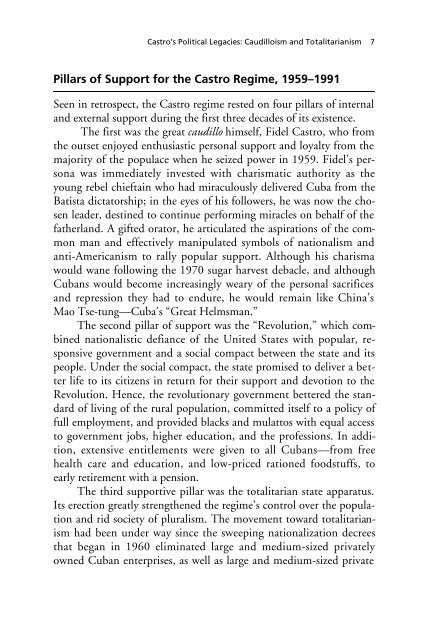Cuba After Castro - RAND Corporation
Cuba After Castro - RAND Corporation
Cuba After Castro - RAND Corporation
You also want an ePaper? Increase the reach of your titles
YUMPU automatically turns print PDFs into web optimized ePapers that Google loves.
<strong>Castro</strong>’s Political Legacies: Caudilloism and Totalitarianism 7<br />
Pillars of Support for the <strong>Castro</strong> Regime, 1959–1991<br />
Seen in retrospect, the <strong>Castro</strong> regime rested on four pillars of internal<br />
and external support during the first three decades of its existence.<br />
The first was the great caudillo himself, Fidel <strong>Castro</strong>, who from<br />
the outset enjoyed enthusiastic personal support and loyalty from the<br />
majority of the populace when he seized power in 1959. Fidel’s persona<br />
was immediately invested with charismatic authority as the<br />
young rebel chieftain who had miraculously delivered <strong>Cuba</strong> from the<br />
Batista dictatorship; in the eyes of his followers, he was now the chosen<br />
leader, destined to continue performing miracles on behalf of the<br />
fatherland. A gifted orator, he articulated the aspirations of the common<br />
man and effectively manipulated symbols of nationalism and<br />
anti-Americanism to rally popular support. Although his charisma<br />
would wane following the 1970 sugar harvest debacle, and although<br />
<strong>Cuba</strong>ns would become increasingly weary of the personal sacrifices<br />
and repression they had to endure, he would remain like China’s<br />
Mao Tse-tung––<strong>Cuba</strong>’s “Great Helmsman.”<br />
The second pillar of support was the “Revolution,” which combined<br />
nationalistic defiance of the United States with popular, responsive<br />
government and a social compact between the state and its<br />
people. Under the social compact, the state promised to deliver a better<br />
life to its citizens in return for their support and devotion to the<br />
Revolution. Hence, the revolutionary government bettered the standard<br />
of living of the rural population, committed itself to a policy of<br />
full employment, and provided blacks and mulattos with equal access<br />
to government jobs, higher education, and the professions. In addition,<br />
extensive entitlements were given to all <strong>Cuba</strong>ns––from free<br />
health care and education, and low-priced rationed foodstuffs, to<br />
early retirement with a pension.<br />
The third supportive pillar was the totalitarian state apparatus.<br />
Its erection greatly strengthened the regime’s control over the population<br />
and rid society of pluralism. The movement toward totalitarianism<br />
had been under way since the sweeping nationalization decrees<br />
that began in 1960 eliminated large and medium-sized privately<br />
owned <strong>Cuba</strong>n enterprises, as well as large and medium-sized private

















